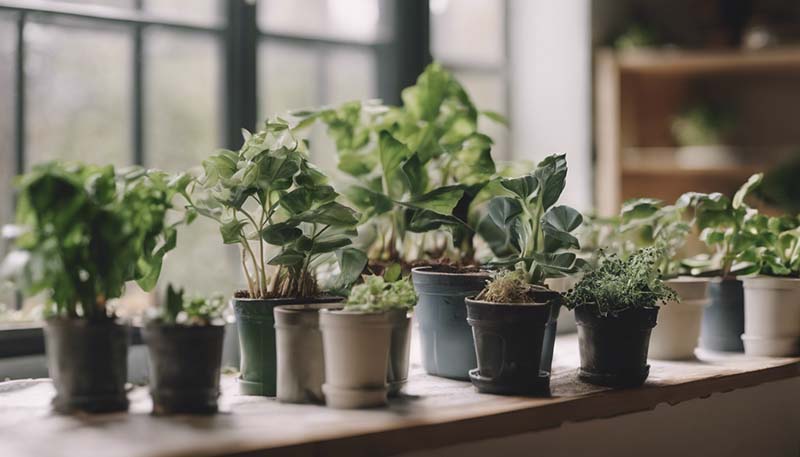Indoor gardening is a wonderful way to bring nature into your home and enjoy the many benefits of plants, such as air purification, stress reduction, and a connection to the natural world. However, traditional indoor gardening methods can sometimes involve materials that are not environmentally friendly or sustainable. In this article, we will explore how to create a sustainable indoor garden using low-impact materials.
**Introduction to Sustainable Indoor Gardening**
Sustainable indoor gardening is the practice of growing plants indoors in a way that minimizes the negative impact on the environment. This can be achieved by using eco-friendly materials, conserving resources, and adopting practices that promote the health and well-being of both the plants and the people who care for them.
Advertisement
**Why Use Low-Impact Materials?**
Using low-impact materials in indoor gardening is important for several reasons:
1. **Environmental Impact**: Traditional gardening materials, such as plastic pots and synthetic fertilizers, can have a significant negative impact on the environment. By choosing eco-friendly alternatives, you can reduce your carbon footprint and promote sustainability.
2. **Health Benefits**: Low-impact materials are often made from natural, non-toxic substances that are safe for both humans and plants. This can help to reduce exposure to harmful chemicals and promote a healthier indoor environment.
3. **Cost-Effective**: Many low-impact materials are durable and long-lasting, which can save you money in the long run. Additionally, some sustainable materials can be repurposed or recycled, further reducing costs.
**Types of Low-Impact Materials for Indoor Gardening**
There are many types of low-impact materials that can be used in indoor gardening. Here are some examples:
1. **Pots and Containers**: Instead of using plastic pots, consider using ceramic, terracotta, or wooden containers. These materials are biodegradable and can provide a more natural look for your indoor garden.
2. **Soil and Growing Media**: Opt for organic, chemical-free soil and growing media, such as coconut coir, peat moss, or vermiculite. These materials are sustainable and promote healthy plant growth.
3. **Fertilizers**: Avoid synthetic fertilizers and instead use organic options, such as compost, worm castings, or fish emulsion. These natural fertilizers are better for the environment and promote healthy plant growth.

4. **Pest Control**: Instead of using chemical pesticides, consider using natural pest control methods, such as introducing beneficial insects, using insecticidal soap, or employing physical barriers.
5. **Watering Systems**: Consider using a drip irrigation system or self-watering containers to conserve water and promote efficient watering practices.
**Designing a Sustainable Indoor Garden**
When designing a sustainable indoor garden, consider the following tips:
1. **Choose the Right Plants**: Select plants that are suitable for indoor growing and can thrive in your home\'s light and temperature conditions. Native plants or those that are adapted to your region are often a good choice.
2. **Maximize Space**: Use vertical space by using wall-mounted planters, hanging baskets, or tall plant stands. This can help you grow more plants in a smaller space.
3. **Create a Balanced Ecosystem**: Incorporate a variety of plant types, such as flowering plants, foliage plants, and herbs. This can help to create a balanced ecosystem that is more resilient and less prone to pests and diseases.
4. **Use Recycled Materials**: Get creative and use recycled materials in your indoor garden. For example, repurpose old cans, bottles, or containers as planters.
5. **Incorporate Natural Elements**: Use natural materials, such as wood, stone, or pebbles, to create a natural and inviting environment for your indoor garden.
**Maintaining a Sustainable Indoor Garden**
Maintaining a sustainable indoor garden requires ongoing care and attention. Here are some tips for keeping your indoor garden healthy and thriving:
1. **Regular Pruning**: Prune your plants regularly to remove dead or diseased leaves and promote healthy growth.
2. **Monitor Watering**: Keep an eye on your plants\' watering needs and adjust your watering schedule as needed. Overwatering or underwatering can both be detrimental to plant health.
3. **Rotate Plants**: Rotate your plants periodically to ensure that they receive an even distribution of light and prevent leggy growth.
4. **Compost**: Start a small compost bin to recycle plant waste and create nutrient-rich compost for your indoor garden.
5. **Educate Yourself**: Stay informed about sustainable gardening practices and continue to learn about new and innovative ways to reduce your environmental impact.
**Conclusion**
Sustainable indoor gardening is an excellent way to enjoy the benefits of plants while minimizing your impact on the environment. By using low-impact materials and adopting sustainable practices, you can create a beautiful and eco-friendly indoor garden that promotes health, well-being, and a connection to nature.
Comment